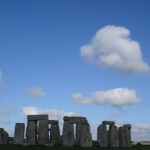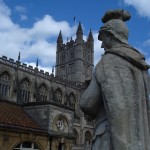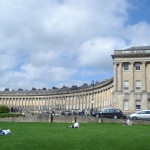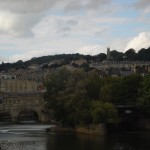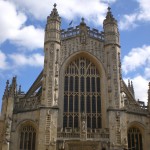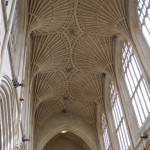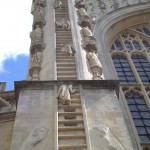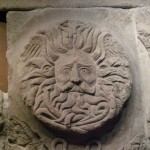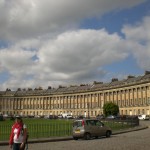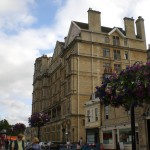Entries from August 2009
August 29th, 2009 · 1 Comment
Last Thursday morning at 8 a.m. both the Humanities and Science programs piled on a bus and began our first journey outside of London since arriving almost exactly a week before. Our first stop on the journey was Stonehenge. Going into it I had mixed feelings about this collection of rocks. From what I had seen on television and from what I had read about Stonehenge they seemed so mysterious and fascinating. I guess I was worried that actually going to Stonehenge would somehow sour their mystique to me. I didn’t want something that I had always considered so majestic to all of a sudden lose its aura of greatness. In addition I had been told by friends who had been on the Norwich Humanities program before that Stonehenge did not meet their expectations.
After about a two hour bus ride we pulled off a highway and at the top of a hill we saw our destination in the middle of a field. Upon arrival Aidan and I joked about the famous scene in “This Is Spinal Tap” where the band accidentally receives miniature Stonehenge models for their rock concert that are about half the size of dwarves that are dancing a jig around them. Once I received my electronic tour device I headed up to the top of the hill where I proceeded to take a multitude of pictures from all angles and vantage points. The tour device was helpful and helped me understand the figure as more than just a pile of rocks. Overall I was not disappointed by Stonehenge and it did not lose its mystique for me but I was glad that we only spent an hour at the site. There really isn’t much to do there once you’ve listened to the tour and used up every picture angle possible.
The next stop on our trip was Bath. Unlike Stonehenge I had heard only positive things about this part of the journey so I went in with fairly high expectations. At the end of the day my expectations were more than satisfied. The ride from Stonehenge to Bath took us through some beautiful English countryside. We passed some classic country houses and weaved in and out of lush valleys the whole journey. While listening to “Stairway to Heaven” on the bus ride over I attempted to envision Robert Plant and Jimmy Page sitting in the countryside right outside my window, strumming guitars and trying to come up with lyrics for their ’71 masterpiece. As we approached Bath I was immediately impressed by the architecture I observed in the distance. Many of the houses sat on top of a hill separated by a river. A truly remarkable sight.
Once we arrived a bunch of us headed off to find a place to eat lunch. We decided on a half pub/diner type of restaurant where I ordered the Pie of the Day. Overall the food was mediocre for its price. I’m still having a little trouble distinguishing which restaurants appeal to me and which don’t. When in doubt the Fish and Chips in any pub is usually a great choice for me. After lunch we headed to Bath Abbey before our class trip to the Roman Baths. Bath Abbey was gorgeous. Not quite as remarkable or as massive as Westminster but definitely in the same ballpark. Already sensing that the town of Bath would be a place to remember I bought a few postcards in the gift shop and headed over to the baths.
Overall seeing the baths was a great experience. It is amazing and a little disconcerting to me to think that hundreds of years ago a multitude of men bathed in the very same spot that we were walking around in casually and taking pictures. The columns and statues of Romans surrounding the large bath were beautifully done. The water was an odd colour of green so for anyone that would have been tempted to touch it despite the guides warning, this became the final deterrent. I spent about an hour in the Baths before heading up to the Royal Crescent where I would spend the first part of my afternoon. Once I got my fill of the beautiful Georgian Architecture that makes up the crescent I headed over to the park across the street where a bunch of us layed down for about an hour just talking and relaxing.
After a quick coffee break Kelley, Grace and I decided to take a walk around the nearby river. This was easily my favorite part of the trip. The view up the river looking into the town was incredibly picturesque. On this walk I got a sense of the true/non-touristy feel of Bath. There were parks, small trinket shops along the river and even a rugby pitch. Maybe most tourists just don’t have the time for it during their excursions to Bath but the path along the river was wonderful and I would head back there in a heartbeat to explore more of the area.
Overall my trip to Bath helped me conclude a number of things. The first is that, as much as I love being in London, I definitely prefer a smaller town atmosphere a little out of the way. The second thing this trip confirmed is that the English Countryside is just as beautiful as people have told me. Despite my need for sleep on the 2 hour bus ride back to London I resisted because I enjoyed observing the landscape so much. If I have some time later in the year I would definitely return to Bath. There is still a lot to see.
Tags: Churches and Cathedrals · Henry
Let me preface all of this by saying that I am, as my fellow classmates have stated, incredibly grateful for the opportunity to see both Stonehedge and Bath– two great world heritage sites. Both trips were incredible and photograph-worthy (believe me, I took enough pictures for the entire year that day). I, however, do not share my classmates’ adoration of the city of Bath. I doubt a person exists in the world who doesn’t find the city to be one of beauty. That being said, a city built to cater to tourists is one that does not rank on my list of favorite places in the world. I recognize that I am a tourist so begrudging a city for catering to me sounds a bit odd. Truly though I would rather visit a place to appreciate what it has to offer rather than it intentionally enticing me to visit it by being built around what it thinks I might like.
At the Roman Baths themselves, I found myself most attracted to the Bill Bryson audio option on the audio tour. An author of many travel books, he was well-equipped to take me around the Roman Baths in an educational and still humorous manner. He made a comment at one of the corners that if you looked around you would see how much the site has been altered since the Romans bathed there. Following his advice, I looked around. I saw a water fountain out of which you could drink the very water that the Romans bathed in for a low, low price of fifty pence. I saw a newly remodeled bathroom that was made to look like an authentic Roman bathroom equipped with automatic sinks and hand driers. I saw outside of the baths street performers that were both incredibly talented and incredibly good at attracting large amounts of people. I then realized that I was listening to Bill Bryson. Let’s pause. Listening to him was a great way to get through the museum. But Bill Bryson? Such a recognizable name guarantees that the museum is authentic. Right? Maybe the museum was even it was being invaded by the idea of catering to the tourist while still trying to make a pound or two from the endeavor.
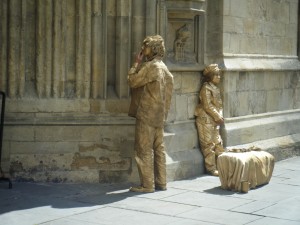
Street performers in Bath
Upon leaving the museum, a fellow student and I decided to try to capture the beauty of the city (because, truly, being built for tourists does have its perks when it comes to the overall visual beauty of the city). Deciding that the top of the hill would bring the best result for such a photo opportunity, we began our ascent. Two hours later, we realized that we were not the only one’s who thought the top of the hill was the best way to view the city. All of the residences were placed up there with beautiful views…and walls surrounding their homes to shield nosy tourists away from enjoying those views. The tourists, it seems, were to stay in the valley where they should be content to watch the street performers, shop around in cutesy boutiques, and listen to the soothing voice of Bill Bryson. I have nothing against such things! But it seems to me that if a tourist is willing to venture away from those confines and really get to know the place that is Bath, they should be able to. If a tourist wants to see and experience the landscape that the city sits upon, the true foundation of the city, they should be able to. It seems that those that profit from keeping the tourists down in the valley have other ideas. Our differences aside, the other student and I were able to get the shot (after two hours of searching). We had to climb up on a wall and duck under a few tree branches to get it, but we were successful nonetheless. When a woman who was walking her dog saw us, she rolled her eyes in a way that suggested she knew our kind all too well. “Tourists” she seemed to sigh. And as she continued to walk by, I was for once happy to have that label to hide behind as reason for my seemingly odd behavior.
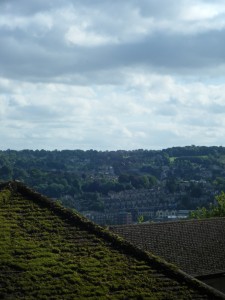
Only one of many picture taken from 'the view'
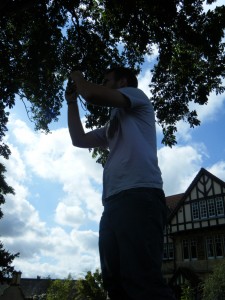
The dedication required to view Bath correctly
Just a side note: the following is a link to the criteria for a world heritage site. It’s just interesting to ponder in relation to what the city of Bath has become. List of criteria for World Heritage Sites
Tags: Audrey
I have to admit that I have not been to many plays in my life. As a matter of fact, the last play I remember attending was in middle school. If I recall correctly it was “Romeo and Juliet,” but I do not remember the performance at all. Fortunately, tonight we were able to see “Troilus and Cressida” in the Globe Theatre. At first, I was a bit apprehensive about standing for three hours and I am sure I wasn’t alone in that regard. Though that is what a “groundling” had to do and trying to recreate it makes The Globe historically accurate, I would have greatly appreciated a chair. Nevertheless, despite the lack of chairs and occasional rain, I thought the play was fantastic.
Every actor did a phenomenal job, the music was incredible and the props were well created. There were too many humorous scenes to mention, but overall the way in which the play was done was amazing. In particular, I thought the fight scenes were very well done. I also enjoyed the drums at the end, which was very unexpected. Perhaps because of all this, I did not realize at the end that three hours had passed. The entire performance was so mesmerizing that it just took me in.
Since I am so used to seeing entertainment through a screen, live acting was a treat. It seemed so much more authentic; the actors were right in front of you and they commanded your attention. I am excited to see more plays while in London and take this new passion back to the States.
Tags: Andrew F
I can honestly say that the day trip to Stonehenge and Bath was one of the best days of my life. First of all, the weather was fantastic and most of my great days start with great weather. Stonehenge was impressive, and I am truly thankful that we were able to visit, but I’m glad it was only allotted one hour of our time. I was really looking forward to the town of Bath, the home of an extremely well preserved Roman Bathhouse, beautiful Georgian architecture and yet another gorgeous Gothic Abbey. As our bus was winding up and around narrow country roads (and I was praying we didn’t run off them) the town came into view. My jaw dropped. In front of me was what appeared to be the quintessentially English country town…. Complete with Jane Austen! Lunch at the Rat and Parrot pub seemed like a good sign, I’ve never been called “dearie” and “love” more times in an hour than I was there. Walking through the bathhouse with my audio guide I learned about the history of the baths and the bathhouse culture of the Romans. While the museum commentary was informative, I ended up listening to Bill Bryson’s commentary rather than the museum. Bryson has a way of making the simplest truth hilarious. Perhaps it’s the way he phrases things, or maybe it’s the delivery. I still don’t know but I was laughing (and, of course learning) the whole time. The case dedicated to the ‘curses’ was especially hilarious. These little tablets were thrown into the waters as an offering to Minerva in hopes that she would grant what they wished. My favorite was the one about the missing cloak, in which the writer wishes all sorts of injury and ill luck upon the man who robbed him. How could this advanced society, this mighty empire, believe that inscribed tablets to the Gods would help them find their misplaces items? These little curses reminded me of Elementary school threats and superstitions… empty and irrational. “Step on a crack and you’ll break your mother’s back!” although, as a first grader it took me weeks to get over that one. The rest of the day was spent admiring the wonderful Georgian architecture and the Bath Abbey. Just as professor Qualls said, the fan-vaulted ceiling was incredible. The amount of detail that is used in a Gothic church always floors me. I don’t think I would have had the patience to complete it. Some of the most interesting elements were the climbing angel sculptures on the towers. I suppose they are meant to be climbing to heaven. I wanted to climb up there to see a better view of the whole town. I would go back to Bath in a heartbeat, anyone up for a weekend trip when we have time?
From one end of the spectrum to the other… the Tate Modern is the sister museum to the Tate Britain, which houses more ‘traditional’ art on the other side of the river. This old factory and warehouse has certainly retained its origins. The minute you walk in you are overpowered by the sheer space. It’s absolutely huge! Although now that I think about it, it is better to have all that empty space from the ground floor to the ceiling for a large instillation or sculpture. Because of time constraints, I was only able to explore one floor of exhibits. But within those two exhibits I was able to satisfy at small part of my quest to find Modern, British art. What do you think of when you think of British art? I always thought of Gainsboro’s portraits of upper class women in their taffeta gowns against a sweeping background of forest of meadows. Until yesterday I could count the number of British artists I had studied in a Dickinson art history class on my fingers. I was able to see some of my favorites in the abstract expressionism gallery. Kirchner and his take on the classic bathers motif (but with garish coloring and hash angles), Matisse and his simple yet powerful paper cutouts, and Lee Krasner’s Gothic Landscapes. When you research Lee Krasner after reading this, (I am sure most of you have never heard of her) please remember to view her art as a separate entity from her husband’s art…. She was a well-established artist in her own right before they were married. But back to the question, what does the art of a Modern Britain look like? I found a few answers in the Surrealism exhibit. Surrealism is fascinating to me. Not only does it explore the role of the subconscious and dreams, the art tends to pair opposite themes and emotions. Whimsy. Violence. Dark. Light. Primitive. Advanced. My first new artist was Roland Penrose. His piece, Portrait (1937) is a mix of words and images that pushed the boundaries of “acceptable” art out the window. Higher-ups who thought the word “arse” was too foul to use in art removed this piece from display. Little did they know that another one of his pieces used sign language to spell out the word “SHIT.” As I moved in to the Realism section I came into contact with several more new names. Margurite Kelsey, Stanley Spencer and Maraude Gueruarva all painted around 1930. The pieces in the Tate Modern all possess an element of mystery. Kelsey uses such fantastic lighting in her work and the style is almost academic, but at the same time thoroughly modern. Cornelia Parker’s instillation, Thirty Pieces of Silver (1988-9) was my favorite piece of the day. The artists had collected silver object, anything ranging form a teaspoon to a trombone and then had then all rolled over by a steamroller. Most of the items were flattened into wafer-thin version of their original shapes. She then arranged the new forms into disks suspended to the ceiling by thin wire. The effect is almost other-worldly. Looking across the room your eye gets lost in the maze of spider silk like threads sprouting from the ceiling. You follow the threads to the floor and “floating” directly above it– the silver disks. Not only are the disks themselves beautiful to look at, the shadows they cast creates an entirely separate work. I tried to look at the shadows and guess what the object above it was. Sometimes I could tell, other times, not so much. The only thing that could have made this instillation better would be the ability to walk all the way around it. At this time you are limited to two sides. Maybe this is how Parker imagined the instillation… Maybe I can try to find a suggestion box next time I am there.


So what is Modern British art? I don’t know that I have seen enough of a range to give you an answer. I can say that yesterday was an education and an experience. I hope to return to the Tate Modern when I have four or five free hours. I’ll call this the beginning of my quest. What do you think? My time here in London is flying by and each day leads me to see or try something new. I am so thankful for this opportunity.
Tags: Grace
Roman Baths
Shakespeare once said: “I’ll say she looks as clear as morning roses newly washed with dew,” and when speaking of the city of Bath, of the experience of standing for three hours at the Globe theatre and of the sight of St.Paul’s Cathedral, I must repeat it. All the places above, in their own ways, masterpieces feeding the soul with a sense of warming delight. Almost like the whipped cream on my caramel frappuccino, never necessary but always crucial for the perfect execution of an unbelievable taste! The city of Bath, acting as the foundation of this reflection represents the coffee itself, the greater mass, as it was a playground for exploration. Troilus and Cressida at the Globe, definitely the unnecessary yet crucial whipped cream… and the cathedral, of course, the delicious caramel, without it the exquisite taste of my Starbucks caramel frap would never be the same. I think I have fallen in love.
White, red, pink, blue, green, yellow, only some of the colors of the flowers that adorned the historical and alluring city of Bath; the perfect place for a New York City girl like me who wishes to scape from the modernity and daily rush of a fast life. Upon arrival, the first sightings of a landscape unknown, beautifully impenetrable by human innovation as it was preserved, almost like frozen in time. To visit such a place right after visiting Stonehenge (a place I have always known of as one of the world’s greatest mysteries) is to think you have had good coffee to later learn that there is better coffee out there. Stonehenge was an amazing structure to observe, the feeling of standing in front of something so simple yet intricate, so brilliant, filled the space with a different spirit. This spirit of some sort followed our bus on our trajectory, reappearing within the walls of the remarkably well-preserved Roman Bath houses, following us through the brick lanes of the city of Bath. Yesterday I lived a feeling like no other, strange and surreal… definitely “morning roses washed with dew.”
Today, accompanied by coffee of my favorite kind, once again, a feeling like no other made its way through my pores, into the deepest parts of my soul. I do not exaggerate when I say that watching Troilus and Cressida was one of the greatest experiences of my life! Broadway does not compare to the feeling of standing in an open roof theatre for three hours, as it rained, watching a masterpiece of literature coming to live right in front of your eyes. Precious. I now see Shakespeare under a whole new light, a light almost as bright as the one’s lighting up the path that led us to stand in front of St.Paul’s as we crossed the Millennium Bridge after the play.
This morning, before heading out on our walk of Southwark we met up in front of St.Paul’s and standing there was eventful, but standing in front of the lit-up cathedral at around 10:40 p.m. was breathtaking. I’m not sure Christopher Wren, when envisioning this space during the 1600’s, would have imagined it to be the immaculate site that it now is. The sighting of the cathedral completed the night, and the words of Prof. Qualls who expressed his gratitude for taking part in these experiences along with his students came at a perfect time.
After evenings of overanalyzing the lack of “my type of art,” as well as “my type of history,” it was refreshing to be reminded of the good caramel frappuccinos I am capable of enjoying during my time in England. And with a Starbucks in every corner I will continue to enjoy the sometimes bitter coffee foundations, the delicious whipped cream and the sweet caramel, meanwhile reminding myself to sip slowly, to fancy every drink and to cherish every burst of flavor. I have fallen in love again with a caramel frappuccino not so different from the one I am used to, and as long as “she looks as clear as morning roses newly washed with dew” I will continue to fall in love again and again.
Some of us have never asked to experience these things, some of us still yearn to. Either way, believe Shakespeare when he notes that “Love sought is good, but given unsought, is better.” I am thankful for having given the chance to love.
Tags: Flow
Walking across the Millenium Bridge tonight (well, it was more like jogging to get out stiffness after three hours as a groundling), I was hit by one of those occasional yet profound moments of realization that I was in London. These moments are few and far between, but when you get a moment to step back and look across the Thames and the glowing lights of the city with St. Paul’s dome looming above you, for example, these realizations can hit you like a ton of bricks.
Similar and not unrelated to the “we’re not in Kansas anymore” feelings are the somewhat more frequent instances of understanding the true amount of history behind London and England themselves. In the past few days, I have seen Stonehenge, Roman baths, Medieval cathedrals, prisons, and fortresses, a Shakespeare play, the Jane Austen Centre, the Cabinet War Rooms, and the Tate Modern. The sheer number of years represented by those few landmarks and events is mind-boggling and can serve to disorient the visitor (especially when the visitor comes from a country that’s only approximately 200 years old). I find it interesting to note that I have an almost reverse levels of admiration for the feats and landmarks viewed: I found it utterly astonishing that ancient peoples were able to move stones weighing many tons across empty fields and then arrange them in circular patterns, but I was unimpressed and even disgusted by the artwork of Paul McCarthy digitally projected on a wall with cutting-edge technology at the Tate Modern. I found the stark, bleak nature of the Cabinet War Rooms and the hard work done there to show the strength and resilience of a country under siege, but I found the crown jewels and the grandeur of the monarchy, both past and present, at the Tower of London to be grandiose and over-the-top for a country that is notorious for a “stiff upper lip” and a “keep calm and carry on” sort of mentality.
I suppose what I’m trying to get across is that the sheer nature of hundreds and thousands of years of history (encompassing invasion, multiple great civilizations, and admirable resilience) on a single, small island weighs heavy on a mind that comes from a vast, expansive country with little history at all that can’t even get a healthcare system sorted out. As we now know, you cannot dig down in London without finding something Roman, Medieval, or even prehistoric, yet they still build on and up, layering the present upon the past, and preserving and commemorating as best they can. In my mind, England is a country that seems to be mostly defined by its past, whereas even though America has a shorter history, it seems mostly defined by its present, including its current political standings, fads and trends, and financial influence. London’s ever-changing face and composition always seems to have the same resilient heart, rooted in thousands of years of invasions, shifts in power, influxes of people, devastating disasters, and new technologies, and it appears able to carry on through anything.
Tags: Chelsea · Churches and Cathedrals · Museums
After the Tate Modern today, I was unsure if anything could improve my day. To be blunt about it, some of the exhibits were just too much for me. I am not a modern art person to begin with and typically only deal with short visits to modern art galleries. Alas, one exhibit at the Tate Modern completely proved to be far too long for me, even though I viewed it for less than a minute. To describe this exhibit, let us say that how Professor Qualls described the “fisting” exhibit was far tamer than it truly is to view. After that, my day seemed tainted by the experience. I mean the War Cabinet Rooms turned out to be a very nice exhibit and one that I enjoyed walking through, but still that exhibit from the Tate stuck with me. Truly, it haunted my thoughts to an extent. It crossed a line between art and the need to attract attention. To me, art centers more on conveying a message or point to those who wish to find it or come across it. It is not a venue in which to shock and horrify people. But those are just my thoughts on that boundary between art and the desire to attract attention.
After that I thought I would be unable to appreciate anything else the city had to offer. Thankfully I was absolutely wrong. Troilus and Cressida was the perfect remedy for what I saw at the Tate Modern. It was my first official Shakespeare play. I had seen scenes from Shakespeare at the RenFaire before, but never an entire play put on by a professional troupe. It went above and beyond anything I could have hoped for and that erased the negative effects that modern art had left on my day. Even with the rain it was a beautiful night to stand and watch Shakespeare. It could not have been a more appreciate or liked show on my part. I only hope that any Shakespeare plays I see after this one live up to the standards it has set.
Tags: Kimberly
Within the past three days I have visited The Tower of London, Stonehenge, the Roman Baths, and the Globe. Visiting these tourist traps has made me realize that in one respect I actually agree with A. N. Wilson, the author of London: A History, I think that the Disney-fication of these places has drastically transformed and even destroyed their historical significance.
When visiting Bath in particular I had trouble grasping that I was actually looking at the real Roman Baths. Not only is this hard for me to fathom this because I have never laid my eyes on something so old, but I also felt that the way they were presented made the idea of their authenticity completely unimaginable. I fold that the amalgam of the old with the new, the numerous signs, and tourists confused me and made it difficult to decipher the authentic from the fake.
I enjoyed every place that I have visited but I feel that attaching a gift shop to a place like Bath and the Tower of London makes them lose all possible historical value, and makes the places feel like an amusement park. After Stonehenge and the Tower of London I was left feeling a sense of unfulfillable and wanting more, almost as though I had missed something.
In fact, I have had a hard time grasping the fact that I am in England at all. The only time that I really started to comprehend that I am actually in England was when we driving through the countryside on our way to Bath. Unlike Stonehenge, the Tower, and the Globe I found this strangely refreshing and honest. There were no tourists snapping a million pictures, fences, snobby people in suits, or signs telling you which buttons to press on your listening device. For me that was England, not the double decker buses nor the red telephone booths with porn pasted on the inside. I am loving London but am anxious to settle in at UEA.

The Jewel House at the Tower of London
Tags: Rebecca
Normally I would leave it to the students to give first impressions of a group event, but I take the lead this time. On a chilly, windy night that threatened (and delivered) intermittent showers, few were likely looking forward to standing as groundlings for three hours to watch one of the great bard’s lesser known plays. How the cast of Troilus and Cressida changed our disposition. Although Wannamaker’s Disneyfied recreation of the Globe envelopes you and slowly makes you forget the forgery, the flight of helicopters above breaks the dream. But no harm when you see a performance like we did tonight. Such a wonderful adaptation of Shakespeare I have rarely seen. Witty and natural dialogue brought even greater life from the words on the page. The remarkably beautiful young men in the cast immediately caused a stir, but their acting was more beautiful still. The range of emotions of the young Cressida (Laura Pyper) was remarkable. The British stage has a bright future with this talented young stable of actors, especially Christopher Colquhoun as Hector, Paul Stocker as Troilus, Beru Tessema as Patroclus, and the stunning Ms. Pyper. Matthew Dunster must be commended for superb direction. Let us not forget the haunting vocals of Olivia Chaney.
But the joy was not limited to a fantastic performance and an after-show stroll across Millennium Bridge to St. Paul’s Cathedral. I think I took most pleasure in watching the responses of the students, some who have never seen Shakespeare performed (and certainly not so close to the stage), who were drawn in to the action. Several commented that they quickly forgot that they were standing for three hours, that the rain had fallen upon us, and that their legs–already weary from a morning’s forced march across Southwark–ached from the week’s activity. This is why I teach…to see young minds gaining new insights and appreciation, growing each day with each new experience.
Twas a magical, dream-like night. This I for one will not soon forget.
Tags: Professor Qualls · Theatre
Sorry to finally be blogging about Wednesday’s events today, the new blog link wasn’t working last night. The number of interesting trips and tours have begun to snowball this week, and blogging about them in a timely way has gotten a bit more difficult.
That said, I feel as though I must write about my experiences on Wednesday, which for me included both Westminster Abbey and the Churchill Museum/Cabinet War Rooms. I’ll echo what I think everyone’s opinion of Westminster Abbey was: unfathomable, in both size and historical importance. I had not realized just how much of the church is dedicated to graves and memorials. It felt overwhelming to be walking from Newton to Darwin to Elizabeth I while flying past David Lloyd George, Edward Elgar, and other very important people for whom the tour just had no time. Certainly no public building other than Westminster Abbey gives an impression of the richness and grandeur and power present in the totality of English history.
And yet, personally, I think I probably got as much out of the Cabinet War Rooms as I did the Abbey. One of the most amazing things about World War Two, I’ve always thought, was that something as powerful as 20th Century Great Britain was brought so close to annihilation, and survived not through brute force but rather determination, cooperation, and strong and unwavering leadership.
Seeing the Abbey and the War Rooms in the same day meant seeing Britain’s at its most epic and powerful and at its simplest, starkest, and truly finest. (Here I’m using juxtaposition, a strategy never before employed on this blog). The Rooms themselves, for those who’ve not yet seen them, are presented with simply an audio guide and some signage, (rather than overblown multimedia) which I think serves them well. Even recreated, they do not appear visually impressive as they were reserved for the PM, the Cabinet and important staff, and there was a minimum of space under the concrete/steel buffer. If one didn’t know the decisions made and the speeches given from that place, one might find it unremarkable.
I might not have recommended the Churchill Museum adjoining the War Rooms if it were on its own. It does gloss over the poorer choices of his career and has quite a confusing setup and superfluous multimedia. My favorite part, frankly, was the loop of video from his remarkable memorial service.
On the tube home I was thinking how tremendous it is that the nerve center of Britain could be confined to those dozen or so rooms in 1940, and only 13 years later it could be back in all its splendor at Westminster Abbey for the coronation of a new queen (with nary a toilet flush to be heard).
Tags: Aidan

